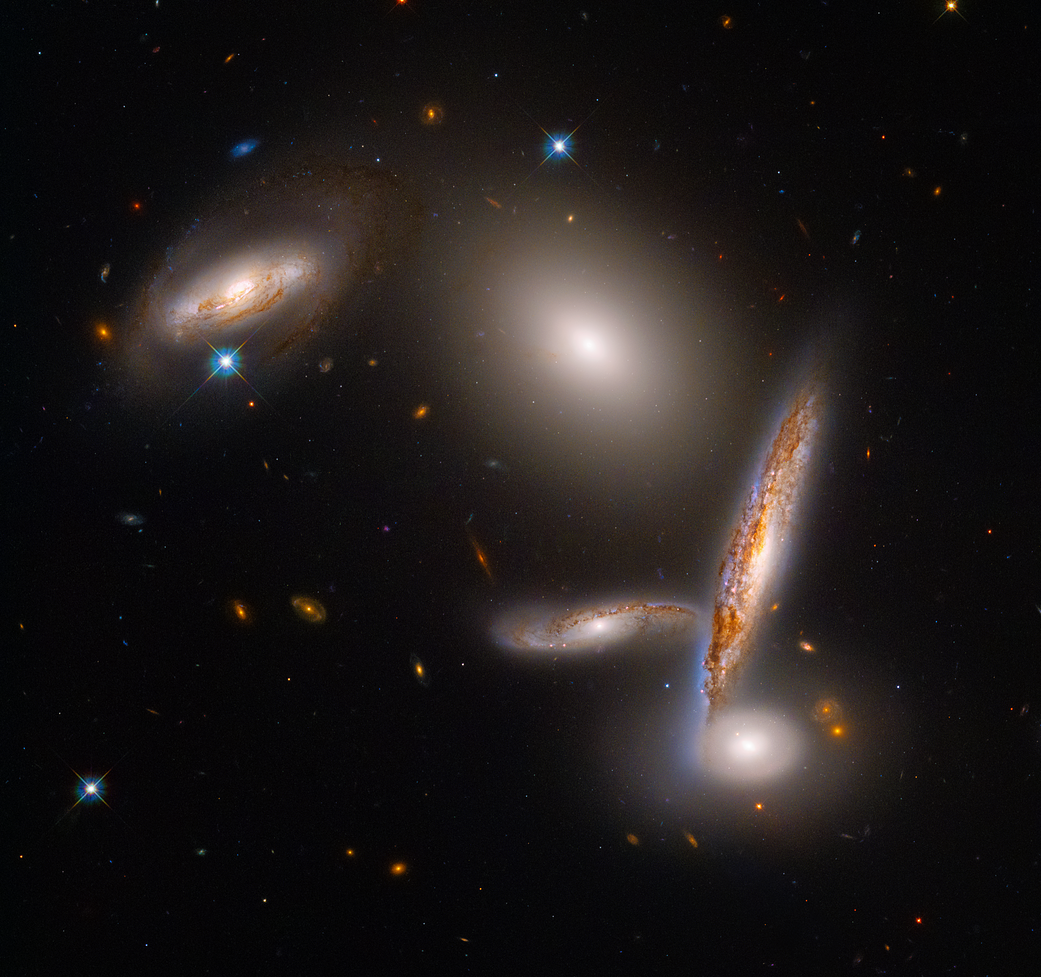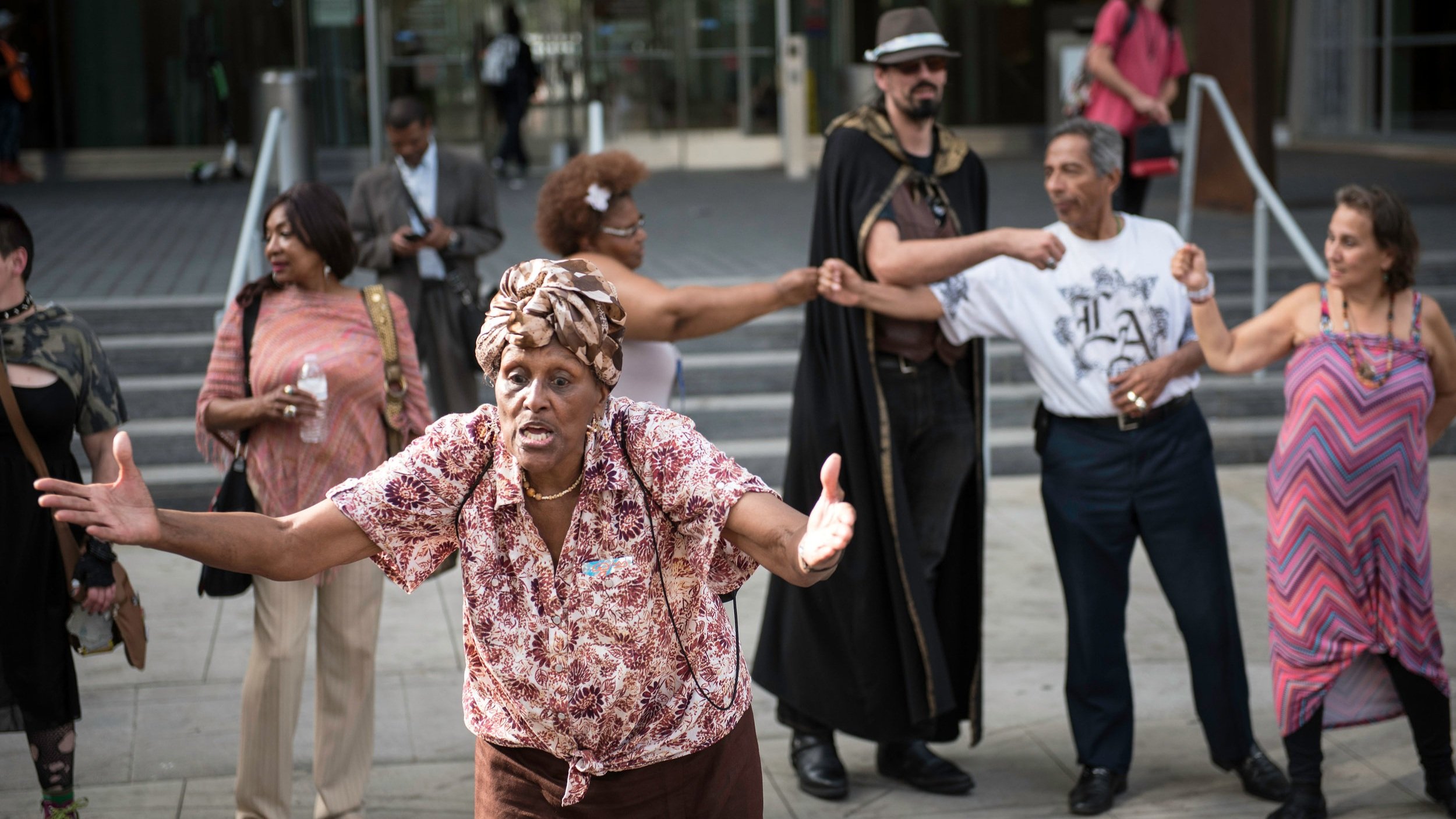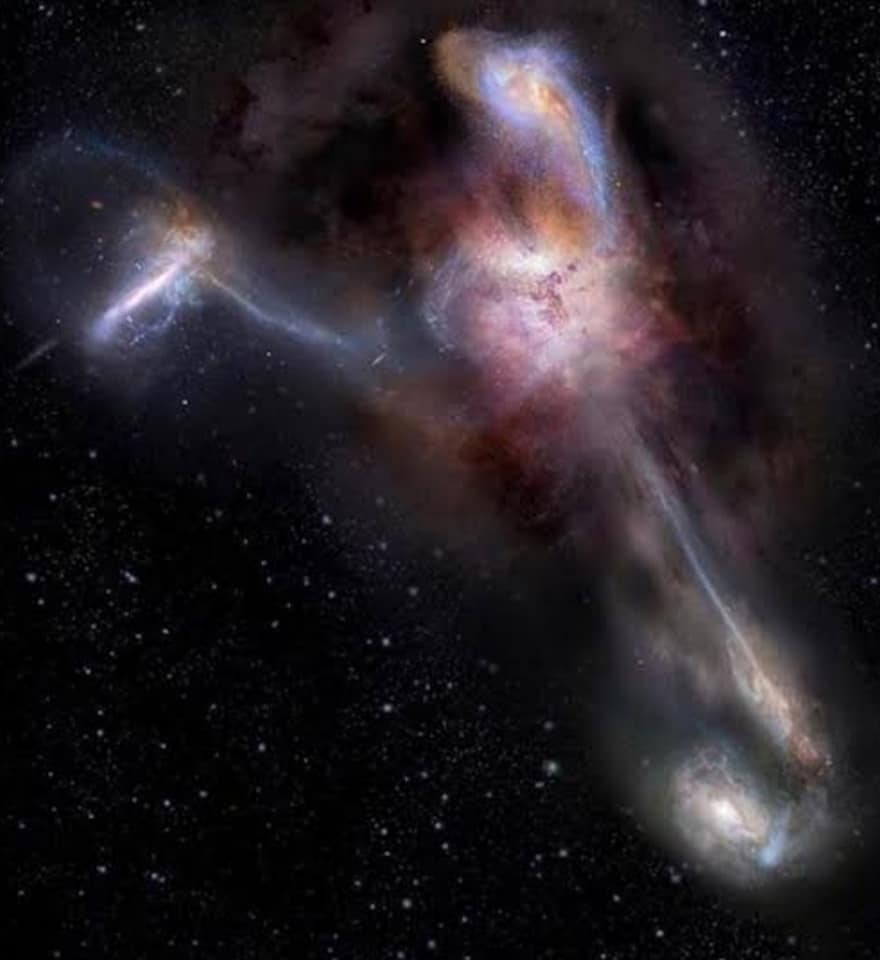Blog
Three spiral galaxies, an elliptical, and a lenticular feature in this Hubble Space Telescope image, all packed into a volume less than 200,000 light-years across, or twice the diameter of the Milky Way’s disk. Their light traveled 300 million light-years before it reached Hubble’s cameras.
At first glance, the five stunning galaxies of Hickson Compact Group 40 look disconnected, placed next to each other in space by chance superposition. But a closer look reveals connections between them, bridges made of gas and stars.
The galaxies make up one of the most crowded compact galaxy groups known, and it’s getting more crowded still. They’re falling inexorably toward each other — in about 1 billion years, there’ll be nothing to see here except for a giant elliptical fuzzball of stars.
Such compact groups might have been more common earlier in the universe’s timeline. Galactic interactions fueled the supermassive black holes that lurk in most galaxy centers and, indeed, most of the galaxies here show evidence of such a central black hole.
The image, taken late last year, was released recently in celebration of the Hubble Space Telescope’s 32nd year of operations. Hubble has far outlived its expected lifetime, having captured 1.5 million images of about 50,000 celestial objects along the way so far. HCG 40 is one more under its belt.

Preston Haynes Love (April 26, 1921 – February 12, 2004) was an American saxophonist, bandleader, and songwriter from Omaha, Nebraska, United States, best known as a sideman for jazz and rhythm and blues artists like Count Basie and Ray Charles.
Preston Love grew up in North Omaha and graduated from North High.
He became renowned as a professional sideman and saxophone balladeer in the heyday of the big band era. He was a member of the bands of Nat Towles, Lloyd Hunter, Snub Mosley, Lucky Millinder and Fats Waller before getting his big break with the Count Basie Orchestra when he was 22.Love played and recorded with the Count Basie band from 1945–1947, and played on Basie’s only No. 1 hit record, “Open The Door Richard.”
more...John Ned Shines (April 26, 1915 – April 20, 1992) was an American blues singer and guitarist.
Shines was born in the community of Frayser, in Memphis, Tennessee. He was taught to play the guitar by his mother and spent most of his childhood in Memphis, playing slide guitar at an early age in juke joints and on the street. He moved to Hughes, Arkansas, in 1932 and worked on farms for three years, putting aside his music career. A chance meeting with Robert Johnson, his greatest influence, gave him the inspiration to return to music. In 1935, Shines began traveling with Johnson, touring in the United States and Canada. They parted in 1937, one year before Johnson’s death.
Shines played throughout the southern United States until 1941, when he settled in Chicago. There he found work in the construction industry but continued to play in local bars.
He made his first recording in 1946 for Columbia Records, but the takes were never released. He recorded for Chess Records in 1950, but again no records were released. He kept playing with blues musicians in the Chicago area for several more years. In 1952, Shines recorded what is considered his best work, for J.O.B. Records. The recordings were a commercial failure, and Shines, frustrated with the music industry, sold his equipment and returned to working in construction.
more...Lakshminarayana Shankar (born 26 April 1950), better known as L. Shankar, Shankar and Shenkar, is an Indian violinist, singer and composer.
Shankar was born in Madras, India, and raised in Ceylon (current-day Sri Lanka), where his father V. Lakshminarayana, a violinist and singer, worked as a teacher at the Jaffna College of Music. He learned to play the violin and first performed in public in a Ceylonese temple at the age of seven. In 1969, he went to the United States, where he studied ethnomusicology at Wesleyan University.
After performing with various Indian singers for several years, Shankar founded a trio with his brothers, L. Vaidyanathan and L. Subramaniam, that performed throughout India.
While attending college at Wesleyan University, he met jazz musicians like Ornette Coleman, Jimmy Garrison, and John McLaughlin. With McLaughlin, Shankar founded the group Shakti in 1975, one of the early groups in which Eastern and Western musical traditions met. They released three albums: Shakti (1975), A Handful of Beauty (1976), and Natural Elements (1977).
more...Theodore Marcus Edwards (April 26, 1924 – April 20, 2003) was an American jazz tenor saxophonist. Edwards was born in Jackson, Mississippi, United States. He learned to play at a very early age, first on alto saxophone and then clarinet.
His uncle sent for him to come to Detroit to live because he felt opportunities were better. Due to illness in the family, he went back to Jackson and ventured to Alexandria, Louisiana. He was persuaded by Ernie Fields to join his band after going to Tampa, Florida. Edwards had planned to go to New York City, but Fields convinced him he could get there by way of Washington, D.C., if he worked with his band. Edwards ended up at the “Club Alabam” on Central Avenue in Los Angeles, which later became his city of residence.
Edwards played with many jazz musicians, including his personal friend Charlie Parker, Roy Milton, Wynonie Harris, Vince Guaraldi, Joe Castro and Ernie Andrews. A 1947 recording with Dexter Gordon, The Duel, was an early challenge to another saxophonist an approach he maintained whenever possible, including a recording with Houston Person. One such duel took place in the 1980s at London’s 100 Club with British tenor Dick Morrissey. In 1964, Edwards played with Benny Goodman at Disneyland, and at the 1964 New York World’s Fair.
more...Zamya Theater will be rehearsing for The zAmya Zone – Homelessness Space Program at the Opportunity Center at Catholic Charities in St Paul. Monday 4-25-22 3-5pm

more...
The ultra-diffuse galaxy GAMA 526784 appears as a tenuous patch of light in this image from the NASA/ESA Hubble Space Telescope. This wispy object resides in the constellation Hydra, roughly four billion light-years from Earth. Ultra-diffuse galaxies such as GAMA 526784 have a number of peculiarities. For example, their dark matter content can be either extremely low or extremely high — ultra-diffuse galaxies have been observed with an almost complete lack of dark matter, whereas others consist of almost nothing but dark matter. Another oddity of this class of galaxies is their anomalous abundance of bright globular clusters, something not observed in other types of galaxies. Hubble captured GAMA 526784 with the Advanced Camera for Surveys (ACS), which was installed in 2002 by astronauts during Hubble Servicing Mission 3B. Since then, the instrument has played a pivotal role in some of Hubble’s most impressive scientific results, including capturing the Hubble Ultra Deep Field. The ACS has also photographed Pluto in advance of the New Horizon mission, observed gargantuan gravitational lenses and found fully formed galaxies in the early Universe. This image comes from a set of Hubble observations designed to shed light on the properties of ultra-diffuse galaxies. Hubble’s keen vision allowed astronomers to study GAMA 526784 in high resolution at ultraviolet wavelengths, helping to gauge the sizes and ages of the compact star-forming regions studding the galaxy.

Carl Allen (born April 25, 1961) is an American jazz drummer. Allen attended William Paterson University.
He has worked with a wide variety of musicians, including Freddie Hubbard, Jackie McLean, George Coleman, Phil Woods, the Benny Green Trio and Rickie Lee Jones.
It was with Green that Allen met bassist Christian McBride. The two have teamed up frequently, working for many combos of big name leaders. McBride recruited Allen for his band, Christian McBride & Inside Straight. Allen is that quintet’s drummer for both its first recording, Kinda Brown, and its road tours.
In 1988 Allen and Vincent Herring founded Big Apple Productions, which produced several albums featuring young jazz performers.
He joined the faculty of The Juilliard School in 2001, and became the Artistic Director of Jazz Studies in 2008. He was replaced as director by Wynton Marsalis in 2013, and left Juilliard at the end of the academic year.
In 2011, Allen appeared as himself in two episodes of the HBO series Tremé, in a studio recording scene in New York City.
In 2014, he formed his own group, The Art of Elvin to pay tribute to Art Blakey and Elvin Jones. The band debuted at the Percussive Arts Society (PAS) conference in Indianapolis, Indiana with Allen on drums, Freddie Hendrix (trumpet), Tivon Pennicott (tenor sax), Xavier Davis (piano), Yasushi Nakamura (bass).
In 2021, Allen joined the faculty of the UMKC Conservatory in Kansas City as the William D. and Mary Grant Endowed Professor of Jazz Studies.
https://www.youtube.com/watch?v=8lVeJd2lvqA
more...Albert Nelson (April 25, 1923 – December 21, 1992), known by his stage name Albert King, was an American blues guitarist and singer whose playing influenced many other blues guitarists. He is perhaps best known for the popular and influential album Born Under a Bad Sign (1967) and its title track. He, B.B. King, and Freddie King, all unrelated, were known as the “Kings of the Blues”. The left-handed King was known for his “deep, dramatic sound that was widely imitated by both blues and rock guitarists.”
He was once nicknamed “The Velvet Bulldozer” because of his smooth singing and large size–he stood taller than average, with sources reporting 6 ft 4 in (1.93 m) or 6 ft 7 in (2.01 m), and weighed 250 lb (110 kg)–and also because he drove a bulldozer in one of his day jobs early in his career.
King was inducted into the Blues Hall of Fame in 1983. He was posthumously inducted into the Rock and Roll Hall of Fame in 2013. In 2011, he was ranked number 13 on Rolling Stone‘s 100 Greatest Guitarists of All Time.
Albert King was born on a cotton plantation in Indianola, Mississippi. During childhood he sang at a church with a family gospel group, in which his father played the guitar. One of 13 children, he grew up picking cotton on plantations near Forrest City, Arkansas, where the family moved when he was eight years old.
more...Ella Jane Fitzgerald (April 25, 1917 – June 15, 1996) was an American jazz singer, sometimes referred to as the “First Lady of Song”, “Queen of Jazz”, and “Lady Ella”. She was noted for her purity of tone, impeccable diction, phrasing, timing, intonation, and a “horn-like” improvisational ability, particularly in her scat singing.
After a tumultuous adolescence, Fitzgerald found stability in musical success with the Chick Webb Orchestra, performing across the country but most often associated with the Savoy Ballroom in Harlem. Her rendition of the nursery rhyme “A-Tisket, A-Tasket” helped boost both her and Webb to national fame. After taking over the band when Webb died, Fitzgerald left it behind in 1942 to start her solo career. Her manager was Moe Gale, co-founder of the Savoy, until she turned the rest of her career over to Norman Granz, who founded Verve Records to produce new records by Fitzgerald. With Verve she recorded some of her more widely noted works, particularly her interpretations of the Great American Songbook.
While Fitzgerald appeared in movies and as a guest on popular television shows in the second half of the twentieth century, her musical collaborations with Louis Armstrong, Duke Ellington, and The Ink Spots were some of her most notable acts outside of her solo career. These partnerships produced some of her best-known songs such as “Dream a Little Dream of Me“, “Cheek to Cheek“, “Into Each Life Some Rain Must Fall“, and “It Don’t Mean a Thing (If It Ain’t Got That Swing)“. In 1993, after a career of nearly 60 years, she gave her last public performance. Three years later, she died at the age of 79 after years of declining health. Her accolades included fourteen Grammy Awards, the National Medal of Arts, and the Presidential Medal of Freedom.
Fitzgerald was born on April 25, 1917, in Newport News, Virginia. She was the daughter of William Fitzgerald and Temperance “Tempie” Henry, both described as “mulatto” in the 1920 census. Her parents were unmarried but lived together in the East End section of Newport News for at least two and a half years after she was born. In the early 1920s, Fitzgerald’s mother and her new partner, a Portuguese immigrant named Joseph da Silva,moved to Yonkers, in Westchester County, New York.
more...Eugene Earl Bostic (April 25, 1913 – October 28, 1965) was an American jazz alto saxophonist and a pioneer of the post-war American rhythm and blues style. He had a number of popular hits such as “Flamingo”, “Harlem Nocturne“, “Temptation”, “Sleep”, “Special Delivery Stomp”, and “Where or When“, which all showed off his characteristic growl on the horn. He was a major influence on John Coltrane.
Bostic was born in 1913 in Tulsa, Oklahoma. He turned professional at the age of 18 when he joined Terence Holder’s “Twelve Clouds of Joy”. Bostic made his first recording with Lionel Hampton in October 1939, with Charlie Christian, Clyde Hart and Big Sid Catlett. Before that, he performed with Fate Marable on New Orleans riverboats. Bostic graduated from Xavier University in New Orleans. He worked with territory bands as well as Arnett Cobb, Hot Lips Page, Rex Stewart, Don Byas, Charlie Christian, Thelonious Monk, Edgar Hayes, Cab Calloway, and other jazz luminaries. In 1938, and in 1944, Bostic led the house band at Smalls Paradise. While playing at Small’s Paradise, he doubled on guitar and trumpet. During the early 1940s, he was a well-respected regular at the famous jam sessions held at Minton’s Playhouse. He formed his own band in 1945 and made the first recordings under his own name for the Majestic label. He turned to rhythm and blues in the late 1940s. His biggest hits were “Temptation“, “Sleep”, “Flamingo“.
more...Linda Womack (née Cooke; born April 25, 1953), now known as Zeriiya Zekkariyas, is an American singer and songwriter. She is the daughter of soul singer Sam Cooke. She later had a successful career as half of the duo Womack & Womack with her husband Cecil Womack.
Linda Womack (née Cooke) is the eldest child of Barbara Campbell and Sam Cooke, born on April 25, 1953. Her parents married in 1958. In December 1964, when she was 11 years old, her father was killed. Soon after, her mother married Cooke’s protégé Bobby Womack on March 5, 1965. In 1970, Barbara shot at him after she discovered he was apparently sexually abusing Linda. According to Womack, Linda never spoke to her mother again after that incident.
In 1972, Linda co-wrote Bobby Womack’s 1972 hit song “Woman’s Gotta Have It“. In 1979, she signed to Capricorn Records and went on the road with him. They planned to collaborate for her debut album. She gained renown as a songwriter of soul songs in the late 1970s and ’80s, with “Love Bankrupt”, released by Patti LaBelle; and the ballad “New Day” by soul singer and jazz guitarist, George Benson.
Linda married Bobby’s brother Cecil Womack, and together they had a successful recording career under the name Womack & Womack. Their first album, Love Wars, released by Elektra Records, was a critical hit. “Baby I’m Scared of You” was a Top 40 R&B single. Other albums included Radio M.U.S.I.C. Man (Elektra 1985), Starbright (Manhattan EMI 1986), Conscience (Island 1988) and Family Spirit on Arista/RCA in 1991. Their 1988 single “Teardrops” from the album Conscience was a worldwide hit. The song, written by Linda and Cecil (as Womack and Womack), featured Linda on lead vocals. The 1993 album Transformation Into The House Of Zekkariyas was their last as Womack & Womack.
In the 1990s, Linda and her family moved to South Africa. She records with her seven children as The House of Zekkariyas. Her husband died on January 25, 2013 in South Africa, aged 65.
more...WISE J224607.57−052635.0 (or W2246−0526 for short) is an extremely luminous infrared galaxy (ELIRG) which, in 2015, was announced as the most luminous known galaxy in the Universe. The brightness is 350 trillion times that of the Sun (349×1012L☉), and the merger of smaller nearby galaxies may be contributing to its brightness. The light is generated by a quasar 10 billion times the mass of the Sun. The optical and ultraviolet light emitted by the accretion disc around the quasar’s supermassive black hole is absorbed by the galaxy’s dust and remitted in the infrared. The galaxy releases 10,000 times more energy than the Milky Way galaxy, although WISE J224607.57–052635.0 is the smaller of the two. WISE J224607.57–052635.0 has a light-travel distance of 12.5 billion light years from it to Earth. The galaxy was discovered using the Wide-field Infrared Survey Explorer.

John Christopher Williams AO OBE (born 24 April 1941) is an Australian virtuosic classical guitarist renowned for his ensemble playing as well as his interpretation and promotion of the modern classical guitar repertoire. In 1973, he shared a Grammy Award in the Best Chamber Music Performancecategory with fellow guitarist Julian Bream for Together (released in the US as Julian and John (Works by Lawes, Carulli, Albéniz, Granados)).Guitar historian Graham Wade has said that “John is perhaps the most technically accomplished guitarist the world has seen.
https://www.youtube.com/watch?v=B5y-2rUcsoU
more...Joe Henderson (April 24, 1937 – June 30, 2001) was an American jazz tenor saxophonist. In a career spanning more than four decades, Henderson played with many of the leading American players of his day and recorded for several prominent labels, including Blue Note, Milestone, and Verve.
Born in Lima, Ohio, United States, Henderson was one of five sisters and nine brothers. He was encouraged by his parents Dennis and Irene (née Farley) and older brother James T. to study music. He dedicated his first album to them “for being so understanding and tolerant” during his formative years. Early musical interests included drums, piano, saxophone and composition. According to Kenny Dorham, two local piano teachers who went to school with Henderson’s brothers and sisters, Richard Patterson and Don Hurless, gave him a knowledge of the piano. He was particularly enamored of his brother’s record collection. It seems that a hometown drummer, John Jarette, advised Henderson to listen to musicians like Lester Young, Stan Getz, Dexter Gordon and Charlie Parker. He also liked Flip Phillips, Lee Konitz and the Jazz at the Philharmonic recordings. However, Parker became his greatest inspiration. His first approach to the saxophone was under the tutelage of Herbert Murphy in high school. In this period of time, he wrote several scores for the school band.
more...John Arnold Griffin III (April 24, 1928 – July 25, 2008) was an American jazz tenor saxophonist. Nicknamed “the Little Giant” for his short stature and forceful playing, Griffin’s career began in the mid-1940s and continued until the month of his death. A pioneering figure in hard bop, Griffin recorded prolifically as a bandleader in addition to stints with pianist Thelonious Monk, drummer Art Blakey, in partnership with fellow tenor Eddie “Lockjaw” Davis and as a member of the Kenny Clarke/Francy Boland Big Band after he moved to Europe in the 1960s. In 1995, Griffin was awarded an Honorary Doctorate of Music from Berklee College of Music.
Griffin studied music at DuSable High School in Chicago under Walter Dyett, starting out on clarinet before moving on to oboe and then alto saxophone. While still at high school at the age of 15, Griffin was playing with T-Bone Walker in a band led by Walker’s brother.
Alto saxophone was still his instrument of choice when he joined Lionel Hampton‘s big band, three days after his high school graduation, but Hampton encouraged him to take up the tenor, playing alongside Arnett Cobb. He first appeared on a Los Angeles recording with Hampton’s band in 1945 at the age of 17.
more...More Posts
- Daily Roots Eric Morris
- Santa & Jesus Expression of Love
- Challenge to Change at Wildflower Coffee
- Cosmos IC 1805
- Carlton Barrett
- Eddie Kendrick
- Art Neville
- Paul Butterfield
- James Booker
- World Music Lebeha Drummers
- Daily Roots Scientist
- Cosmos NGC 2566
- Sugar Blue
- Robben Ford
- Ludwig van Beethoven
- John Abercrombie
- “Johnny Hammond” Smith
- World Music Dr Jyotsna Srikanth
- Daily Roots Scientist
- Zakir Hussain Performance